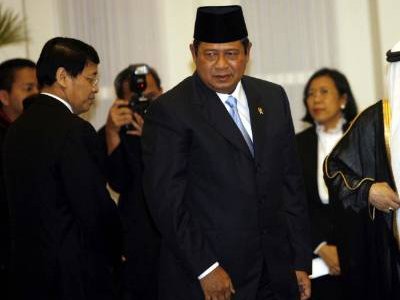Consistent stagnation and decline of the old political parties in the last three elections are also apparent. PDI-P which came out victoriously in 1999 with 33.7 per cent of the votes and 33.3 per cent of the seats has experienced steady decline, gaining only 18.3 per cent of the votes and 19.82 per cent of the seats in 2004, and about 14 per cent of the votes in 2009. Golkar which survived the change, gained 22.4 per cent of the votes and 26 per cent of the of seats in 1999, but failed to perform better in the next two elections. Although it became the largest party in the parliament in 2004, its vote and share of seat declined to 21.6 per cent and 23.3 per cent, respectively.
In the 2009 election, Golkar only got about 14 per cent of the votes. PPP also experienced a steady decline, getting 10.7 per cent of the votes and 12.6 per cent of the seats in 1999, 8.16 per cent of the votes and 10.5 per cent of the seats in 2004, and it may get only about 5.5 per cent of votes in 2009.
What can we learn from these trends?
First, party membership and party attachment (or affiliation) are things of the past. People no longer identify themselves strongly with one or another party. Party membership is declining. Among those who have a membership card, it is not uncommon to find party members who hold multiple memberships. Although die-hard loyalists are still present, their number is declining significantly. Claims by Golkar and PDI-P leaders that their parties have a strong base in certain regions fail to take into account that their bases have been eroded.
Second, political parties should know that having party machinery alone is not enough. They need to have party machineries that work! Golkar, PDI-P, and PPP have claimed that, as the three oldest and most established political parties in Indonesia, they have the largest party machinery and organizational network. However, they fail to take into account that many parts of that huge machinery and organizational network are no longer functioning.
Third, political parties in Indonesia are increasingly dependent, if not too dependent, on media and political advertising to win elections. This pattern was noted by Schmitter several years ago when he identified the evolving political landscape in today’s democracies.
Technology and media have become an integral part of democracy. Parties and candidates out of necessity have become increasingly dependent on the media to reach voters. As one Golkar candidate told me: ‘In one day we can only meet an average of one thousand voters. Through the media you can reach at least a hundred times more.’ In 2004, it was PDI-P and Golkar who spent the largest amount on their media campaigns. In 2009, it was PD and Gerindra. Clearly, those that spent most for the media also reap their share of success.
Fourth, ‘personalism’ has become the name of the game. Charismatic figures and popular candidates have been a decisive factor in party performance in the 2009 election. PD with Susilo Bambang Yudhoyono, Gerindra with Prabowo, and PAN with the multitudes of movie artists as their candidates are evidence of the importance of personalism.
The inability or perhaps the unwillingness of so-called old political parties; Golkar, PDI-P, and PPP; to take these developments into account and effectively adjust to these trends have led to their electoral failure.
Sunny Tanuwidjaja is a researcher in the Department of Politics and International Relation at the Centre for Strategic and International Studies, Jakarta. He is a PhD candidate in political science at Northern Illinois University. Visit his homepage here.

